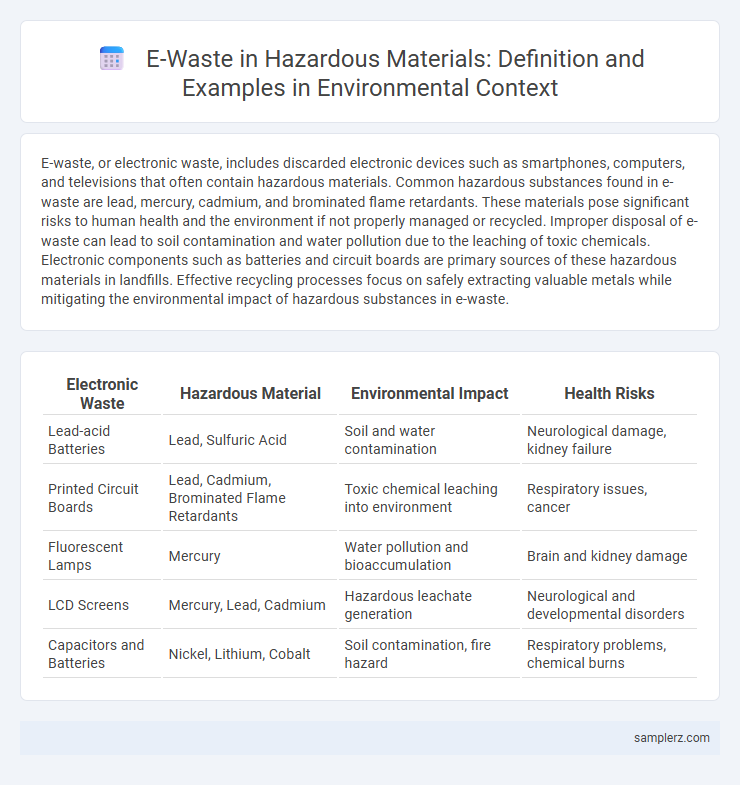E-waste, or electronic waste, includes discarded electronic devices such as smartphones, computers, and televisions that often contain hazardous materials. Common hazardous substances found in e-waste are lead, mercury, cadmium, and brominated flame retardants. These materials pose significant risks to human health and the environment if not properly managed or recycled. Improper disposal of e-waste can lead to soil contamination and water pollution due to the leaching of toxic chemicals. Electronic components such as batteries and circuit boards are primary sources of these hazardous materials in landfills. Effective recycling processes focus on safely extracting valuable metals while mitigating the environmental impact of hazardous substances in e-waste.
Table of Comparison
| Electronic Waste | Hazardous Material | Environmental Impact | Health Risks |
|---|---|---|---|
| Lead-acid Batteries | Lead, Sulfuric Acid | Soil and water contamination | Neurological damage, kidney failure |
| Printed Circuit Boards | Lead, Cadmium, Brominated Flame Retardants | Toxic chemical leaching into environment | Respiratory issues, cancer |
| Fluorescent Lamps | Mercury | Water pollution and bioaccumulation | Brain and kidney damage |
| LCD Screens | Mercury, Lead, Cadmium | Hazardous leachate generation | Neurological and developmental disorders |
| Capacitors and Batteries | Nickel, Lithium, Cobalt | Soil contamination, fire hazard | Respiratory problems, chemical burns |
Common E-Waste Items Classified as Hazardous Materials
Common e-waste items classified as hazardous materials include discarded batteries, cathode ray tube (CRT) monitors, and fluorescent lamps, which contain toxic substances such as lead, mercury, and cadmium. These hazardous components pose significant environmental and health risks if improperly disposed of, leading to soil and water contamination. Proper recycling and disposal methods are essential to mitigate the harmful effects of these materials on ecosystems and public health.
Toxic Components Found in Discarded Electronics
Discarded electronics often contain toxic components such as lead, mercury, cadmium, and brominated flame retardants, which pose significant environmental and health risks when improperly disposed of. Lead, commonly found in cathode ray tubes and solder, can cause neurological damage, while mercury in switches and batteries affects the nervous system. Cadmium, present in rechargeable batteries, and brominated flame retardants used in plastic casings contribute to soil and water contamination, threatening ecosystems worldwide.
Household Electronics Contributing to E-Waste Pollution
Household electronics such as discarded smartphones, laptops, and televisions contain hazardous materials like lead, mercury, and cadmium that significantly contribute to e-waste pollution. Improper disposal of these items leads to toxic substances leaching into soil and water, posing severe environmental and health risks. Recycling programs and responsible disposal methods are essential to mitigate the impact of hazardous e-waste from consumer electronics.
E-Waste Types Requiring Hazardous Waste Disposal
E-waste types requiring hazardous waste disposal include devices containing lead, mercury, cadmium, and brominated flame retardants, such as cathode ray tube (CRT) monitors, fluorescent lamps, batteries, and printed circuit boards. These hazardous substances can leach into soil and water, causing severe environmental contamination and health risks. Proper recycling and disposal protocols are essential to safely manage these materials and prevent toxic exposure.
Popular Gadgets Containing Harmful Substances
Popular gadgets such as smartphones, laptops, and tablets contain hazardous materials like lead, mercury, cadmium, and brominated flame retardants that contribute significantly to e-waste toxicity. These substances pose serious environmental and health risks when improperly disposed of, contaminating soil and water. Proper recycling of these devices is crucial to mitigate the release of these harmful chemicals and reduce the impact on ecosystems.
Examples of Electronic Devices with Environmental Risks
Electronic devices such as smartphones, laptops, and televisions contain hazardous materials like lead, mercury, and cadmium that pose significant environmental risks when improperly disposed of. Batteries in these devices often include toxic chemicals that can leach into soil and groundwater, causing pollution and health hazards. Proper recycling and disposal of e-waste are essential to mitigate contamination and protect ecosystems from these dangerous substances.
Everyday Electronics as Sources of Hazardous E-Waste
Everyday electronics such as smartphones, laptops, and televisions contain hazardous materials like lead, mercury, and cadmium that contribute significantly to e-waste pollution. Improper disposal of these devices releases toxic substances into soil and water, posing severe environmental and health risks. Recycling programs targeting these common electronics reduce hazardous waste buildup and promote the recovery of valuable materials.
Small Appliances and Their Toxic E-Waste Impact
Small appliances such as toasters, hair dryers, and electric kettles contain hazardous e-waste components like lead, mercury, and cadmium that pose significant environmental risks when improperly disposed of. These toxic materials can leach into soil and water, causing contamination that harms ecosystems and human health. Proper recycling of small appliances is crucial to mitigate the release of these dangerous substances into the environment.
Computer Equipment Identified in Hazardous E-Waste
Computer equipment such as monitors, printers, and motherboards contain hazardous materials like lead, mercury, and cadmium, making them prominent examples of hazardous e-waste. These toxic substances can leach into soil and water, posing significant environmental and health risks. Proper recycling and disposal methods are essential to mitigate the environmental impact of these hazardous components in discarded computer equipment.
Mobile Devices and Their Role in Hazardous Material Waste
Mobile devices, including smartphones, tablets, and laptops, contribute significantly to e-waste due to hazardous materials such as lead, mercury, cadmium, and brominated flame retardants present in their components. Improper disposal of these devices releases toxic substances into the environment, contaminating soil and water, and posing health risks to humans and wildlife. Recycling programs targeting mobile devices are essential to recover valuable materials and prevent hazardous waste from entering landfills.

example of e-waste in hazardous material Infographic
 samplerz.com
samplerz.com